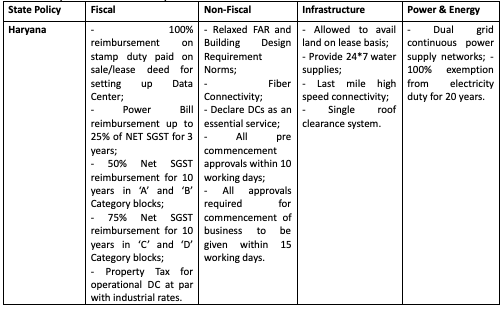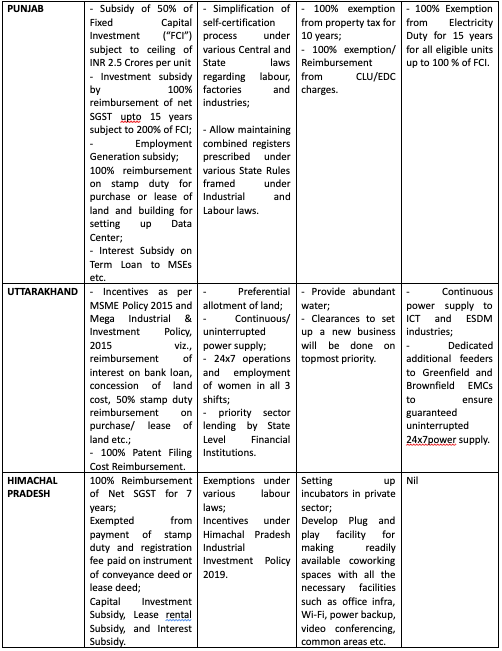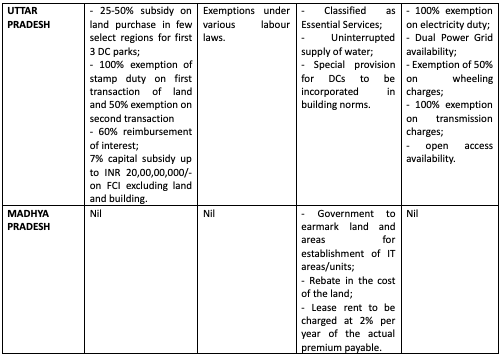“The Rise of Data Centers in India: Exploring the Growth and Challenges”.
- Introduction
During recent years, the Indian Data Centre (DC) industry is expanding rapidly. India has become a fast growing DC hub pursuant to a massive and growing internet userbase, explosion of data, and establishment of a favourable environment through the government’s Digital India initiative. A Data Centre is a dedicated secure space within a building/ centralized location where computing and networking equipment is concentrated for the purpose of collecting, storing, processing, distributing, or allowing access to large amounts of data (1). This digital data and applications are stored on cloud servers in a DC and accessible to users via broadband connectivity. Servers at these DCs, compute and process relevant data in response to user requests, making the desired information available to the user.
- Need of Data Centre
The rising adoption of digital transactions, Internet of Things (IoT) and smart devices over the last few years alone has created a significant demand for digital services; and more importantly, DCs (2). With the acceleration of the digital economy in India, following concerns have arisen over the seamless flow of data:
- Data storage on foreign servers, which curtails access for domestic national security agencies.
- The loss of economic benefits as data are more meaningfully exploited by foreign firms.
- Fear of foreign surveillance.
- Personal data misuse in violation of privacy rights.
The aforementioned issues including centralization and localization of data paved the way for establishment of DCs in India.
- Types of Data Centres
- Enterprise Data Centres: These proprietary DCs are built & owned by the organizations for their internal end-users. They support the IT operations and critical applications of a single organization and can be located both on-site and off-site.
- Managed Services Data Centres: These provide comprehensive management and maintenance of IT infrastructure and applications for businesses. These third party DCs provide services related to management of servers, data storage, networking, security systems and computing services. Companies prefer to lease the infrastructure, and services from them, instead of buying.
- Cloud-based Data Centres: These off-site distributed DCs are facilities that provide on-demand computing resources to businesses and individuals via the internet and are managed by the third-party or public cloud providers, such as Amazon Web Services, Microsoft Azure or Google Cloud.
- Colocation Data Centres: are facilities that provide space, power, and cooling for companies to host their servers and other computing equipment. In a colocation DC, multiple companies share the infrastructure, physical space, band width, cooling and security systems which makes it appealing to those organizations that are not willing to spend large capital expenditures associated with building and for maintaining their own DCs.
- Edge Data Centres: These are comparatively smaller facilities that solve the latency problem by being geographically closer to the edge of the network and data sources. Such DCs enable new applications by reducing latency, improved application performance and optimizing bandwidth.
- Hyperscale Data Centres: are designed to provide large scale computing and data storage capabilities and are synonymous with large-scale providers, such as Amazon, Meta and Google. These hyperscale computing infrastructures maximize hardware density, while minimizing the cost of cooling and administrative overhead.
3. Data Centre Policy
Establishment of DCs in India attracts certain advantages, for instance, accessibility of land and raw materials; strategic geographical position from a global perspective; well-established worldwide connectivity via submarine cables in cities like Mumbai and Chennai; a skilled workforce along with constant and economical power supply in selective zones (3). Additionally, the DC Policy addresses certain challenges in setting up DCs such as lack of infrastructure or industry status of the DCs, absence of specialized building norms for building the DCs, delayed approvals, complex clearance processes, high cost of power, lack of published standards with regard to setting up and operations, submarine cable network connectivity limited to few states and high cost of capital as well as excessive operational expenditure.
3.1 Features
- Infrastructure Status: The DC Policy provides a blueprint of the growth of DC Sector (DCS) in India. The DC Policy lays out that an “Infrastructure Status” be imputed to DCS to allow them to avail the benefits of long-term credit from lenders at easier terms.
- Data Centre Incentivization Scheme: The DC Policy proposes the formulation of DC Incentivization Scheme (DCIS) which will, inter alia, specify fiscal and non-fiscal incentives for DCS, use of domestic equipment relating to servers, storage, telecom, network devices, electrical, cooling equipment, etc.
- Favourable Ecosystem for Operation of Data Centres: The Indian Government with a view for long term growth for DCs has put forth the proposal to provide uninterrupted, clean and cost-effective supply of electricity; to provide cost-effective connectivity backhaul; provide the status of ‘essential services’ as per the Essential Services Maintenance Act, 1968 to DCs to enable seamless continuity of services even during force majeure situations; and frame specialized code in the National Building Code of India to facilitate specialized construction and safety approvals for DC buildings.
- Data Centre Economic Zones (DCEZs”): to set up 4 Data Centre Economic Zones (DCEZ) in the country so that the DCs located in these zones can enjoy some additional incentives.
- Promotion of Indigenous Technology Development, R&D and Capacity Building: in addition to promotion of usage of indigenous technology in DCs for reducing overall import of goods and services, incentivize global equipment manufacturers to set up manufacturing units of IT/ Non-IT components in India, catering not only to local demands but also for export purposes.
4. Challenges
- Simplify Clearances for Setting up Data Centres: While the idea of simplifying clearances for DCs is praiseworthy, it should not be limited to setting single window clearance mechanism or publishing a list of approvals required. India’s tryst with single window clearance systems has not been encouraging as applicants still have to pursue different departments to issue necessary approvals. Thus, there is a need to adopt a regulatory framework for all the approvals to be obtained in a single go to help in doing away with sub-optimal requirements and simplify the clearance mechanism for DCs in India.
- Security of Data and Risk Assessment: DCs store plenty of information. The DC Policy suggests the observance of minimum standards for IT, non-IT and security and adoption of services from the state of the art to maintain the security of DCs along with data confidentiality, integrity, and availability. However, there is no provision regarding breach reporting/disclosure, risk management or audit exercises, etc. in the DC Policy. The Data Protection Bill, 2019 covers protection of only personal and sensitive data by sticking to the minimum standards, which is not up to snuff to safeguard data of any nature.
- Physical Security of Data Centres: The DC Policy puts the measures for the physical security of the DCs on back burner and leaves the issue of regulating the security of the DCs on the Ministry of Electronics and Information Technology (MeitY). In the event of a natural disaster or any other plight, the DC Policy does not address physical security of DCs or takes into account issues relating to data backup, infrastructure connection, and governance policies.
- Grievance Redressal Mechanism for Data Centres – One of the primary objectives of the DC Policy is to create an institutional governance mechanism. The Policy also aims for a single window compliance system for DCs and a DC Industry Council. However, the DC Policy does not provide any provision for grievance redressal for the speedy resolution of problems encountered in setting up or arising out of operations.
- Winding Up Procedures and Migration of Data Outside the Data Centre/ Country: Ease of doing business encompasses all phases of a business, from setting up to winding up. On the other hand, the DC Policy is all about setting up DCs and DC Parks; but it is silent about the winding up procedures relating to a DC.
- State Data Centre Policy
The race for providing faster access to data and creating employment has driven various States to come up with the policies for setting up of local DCs. The State Governments will, inter alia, provide the following support / incentives to DC Parks:
5. Comparison between state policies of a few Indian States



- Regulatory Regime in India
- Storage of Payments System Data: RBI Guidelines
As per these Guidelines, the Payment Service Provider shall ensure that the entire data relating to payment systems operated by them are stored only in India within a period of six months. Further, the data may be shared with the overseas regulator, if required, only with prior approval from RBI. The primary objective behind issuing such guidelines was to reduce the risk of a data privacy breach relating to the information on payments and customer data.
- National E-commerce Policy, 2019 – Draft
The objective of the draft National E-Commerce Policy released by The Department for Promotion of Industry and Internal Trade (DPIIT) is to enable India to benefit from digitisation by creating a governance framework for various stakeholders and strategies for data localisation, consumer protection and promoting MSMEs and start-ups. This Policy addresses six broad areas of the e-commerce ecosystem, i.e., data, infrastructure, development, e-commerce marketplaces, regulatory issues, stimulating domestic digital economy and export promotion through e-commerce.
- The Digital Personal Protection Bill, 2022
The Digital Personal Protection Bill, 2022 is the updated version of the Personal Data Protection Bill, 2019 and is personal data centric and adopts a more streamlined approach to handle the data than its predecessor. Though the said bill promotes the objective of protecting personal data, yet it paves the way for cross border transfer of data by reducing the data localization norms.
The relaxing data localization norms in the said Bill tends to conflict with the existing provisions under the existing laws i.e., norms released by RBI and other draft bills/policies concerning data security. It mandates that the data generated in India shall not be transferred abroad as it is difficult to ensure similar level of protection in other jurisdictions and trace the misconduct in case of breach.
- TRAI Recommendations
The Department for Telecom Regulatory Authority of India (TRAI) has released a draft of recommendations on regulatory framework like the need for the Central Government to define certain fiscal and non-fiscal incentives for DC sector; establishing a time bound single-window clearance system, etc. The objective of these draft recommendation is to promote data economy through the establishment of DCs, content delivery network, and interconnect exchanges in India.
- Land: Critical component for setting up of DCs
Land forms an important requirement for setting up of DCs which can be acquired in the following ways:
Long term lease / conveyance – either from the State Government or the private players where the land has already been acquired / purchased, zoned, for a DC and has necessary infrastructural facilities for setting up a DC.
Standalone DC projects: The salient requirements for setting up both private large estates and/or standalone DC projects are as follows:
- Aggregation and acquisition of lands;
- Obtaining land conversion;
- Development of infrastructure.
The aforesaid requirements are briefly discussed hereunder:
- Aggregation and Acquisition of Lands: this is a complex and challenging process with various legal and regulatory requirements. Key things to be kept in mind to acquire land in India for any project includes:
- Identify a suitable location to ensure that the essential requirements for setting up a DC such as availability of water and electricity, fiber connectivity, access to infrastructure and transportation, adequate contiguous land, zoning and regulatory requirements, are met.
- Conduct a site survey – once a few locations are shortlisted, a site survey be carried out to assess the availability of contiguous land and the approximate cost for acquisition of the land.
- Conduct due diligence – before acquiring land, a pre-acquisition due diligence be undertaken, inter alia, to:
- ascertain the landowners and their rights in such lands;
- tenancy /possessory rights of persons in such land when the same is not vested in the landowners;
- The landowners, tenants and possessors have a capacity to sell, transfer, assign and / or convey the land and whether any permission is required to be obtained from any authority / court viz. in case of minor’s interest, SC lands, restrictions imposed by local land laws etc.
- Encumbrances in land viz., mortgage, lien, prior agreement to sell, encroachment, title defect, restriction on use, litigation/disputes etc.;
- To ensure that the said land is not subject matter of an ongoing or proposed land acquisition process of the State / Central Government/ Authority;
- The lands proposed to be purchased are contiguous;
- Ascertain the restrictions under State / local laws such as land ceiling and/or non-agriculturists not allowed to purchase lands and whether any prior permissions are required for purchase of the said lands;
- Ascertain the zoning of lands and whether conversion thereof for DC would be permissible under the zoning regulations/ master plan;
- Lands are not impacted by environmental issues viz., conservation zone, flood plain, CRZ, reserved forest, Aravalli mountains etc.;
- A village road, revenue rasta, water body, canal, gas pipeline, water channel, hillock etc. traversing through the said land and impact thereof;
- Land contiguity impacted on account of presence of government land and whether the same could be requisitioned / purchased;
- All permissions that would be required to be obtained post acquisition of the land for conversion and use of the land as a DC.
The aforesaid aspects are also important from the perspective of ascertaining the costing of the land to be acquired.
- Negotiation on terms of purchase – Once the identified land is finalized and due diligence has been completed, the price and terms of purchase shall be negotiated with all the landowners. These terms shall be incorporated in Agreements with a timeline to obtain appropriate permissions/ removal of encumbrances, if any. These Agreements should ideally be registered with the jurisdictional Registrars / Sub-Registrars;
- Purchase of land – After the fulfillment of the conditions precedents to purchase, the lands should be purchased, and it shall be ensured that mutations thereof are affected in the revenue / governmental records;
- Land Conversion – Appropriate approvals, permissions and / or licenses shall be obtained from the relevant governmental body / authority for conversion of the lands to the desired use of DC;
- Development of infrastructure: Some of the important things to be considered while developing infrastructure are:
- Power – A reliable and stable power supply is essential for a DC. In addition, the DC should be so designed to have backup generators and battery backup systems, to ensure continuity of operations;
- Cooling – The equipment in a DC generates a lot of heat, which must be managed to prevent overheating and equipment failure. The DC should be designed with efficient cooling systems, such as air conditioning or liquid cooling, to maintain a stable operating temperature;
- Connectivity – A DC requires high-speed and reliable connectivity to ensure that data can be transmitted quickly and efficiently. It should be ensured that the facility has the necessary connectivity. Further, Data cable network shall be properly installed and/or provisioned before development of a DC;
- Security – A DC must be physically and digitally secured to protect against theft, vandalism, and cyber-attacks. It is important to implement robust physical and cybersecurity measures, such as biometric access controls, surveillance cameras, and firewalls;
- Scalability – A DC should be planned to ensure future growth of capacity, power, and cooling requirements.
- Grey Areas
i Dial Before You Dig Policy & Insurance
Dial Before You Dig Policy (DBYDP) allows easy access of information about the underlying network infrastructure before the commencement of digging by government authorities. DBYDP enables authorities responsible for carrying out the construction work to access information about the underlying network cabling infrastructure before digging to minimize cable breaks. However, in a regular framework, departments like Road & Infrastructure, Irrigation, Electricity, Forest, Railways, etc. do not have a cohesive nature of working and communication gap persists. It has been observed that work executed by one department has often been damaged by the other department resulting in loss of funds, and delay/halts in major projects.
As far as DCs are concerned, the laying of data cables/dark cables are the most important parts of building the projects. The DC Policy fails to identify the damages arising by the said issue. Thus, the payment of damages should be considered either in the DC Policy or in the insurance policies for the developers.
ii Circuit Overloads
The transmission and scheduling of electricity is a hassle in summers. The DCs are high-power consuming units and the infrastructure available in India for scheduling of power is not up to the capacity that can sustain DCs. The setting up of DCs could lead to circuit overloads in case of excessive data.
iii Mitigation of high cost of power by open access Power Purchase Agreement (PPA) (Through renewable energy)/setting up their own generating units/ energy exchange.
As DC capacity increases, the power requirement also rises. This is because DCs by design require huge amount of power to process and store data as well as to cool off server racks housing the computing equipment.
Owing to several technological solutions that help in reducing the energy footprint of DCs and make them energy efficient, Green DCs have started gaining traction globally and companies are increasingly opting for renewables to meet their power demand. Further, the tariffs of solar and wind energy are at all-time low, which shall maintain the status quo in the future as well, which might be favourable for building a suitable environment for DCs as it can reduce the costs while entering in the Open Access PPAs or setting up their own generating units/energy exchanges, instead of purchasing electricity from Government Discoms.
iv Environmental Aspect
DCs and cloud computing have a heavy footprint featuring high consumption of non-renewable energy, waste production and CO2 emissions. There are direct and indirect impacts of digital technologies on energy use and emissions and these technologies can either help or hamper global clean energy transitions. The DCs accounted for approx. 300 MT CO2 emissions equivalent to 0.9% of energy related GHG emissions (4).
v Water Requirement
Any ICT equipment, used for storing data, generates heat. To counter this, most devices have a cooling mechanism. An average of 20-22°C is the ideal temperature for DCs to operate, but in India the average temperatures can soar up to 40-45°C during peak summers. The heat generated by ICT equipment at DCs ends up adding to it (5). To counter this, DCs employ various methods like pumped refrigerant and evaporative cooling, to bring the temperature down.
India is one of the few countries which has started to feel the impact of global warming, and the heat waves, according to a report, will only get intense in the coming years. States like Rajasthan and Nagaland have already started to face severe droughts due to rising temperatures and low rainfall.
vi Carbon Credit
Carbon Credit is a tradable certificate or permit representing the right to emit a set amount of carbon dioxide or the equivalent amount of a different greenhouse gas. Carbon credits and carbon markets are a component of national and international attempts to mitigate the growth in concentrations of greenhouse gases.
DC industry uses around 1% of electricity worldwide (6). For DCs, energy-related emissions constitute a large portion of their total environmental footprint. Hence, the development of renewable energy production has a direct impact on the sustainability of their operations, and in turn they have a strong influence on energy markets. Unfortunately, the DC Policy does not provide enough data to cut the mustard regarding the consequences of DCs on environment.
- Way Forward
In June 2022, CRISIL, announced that India’s DC capacity is projected to double to reach 1,700–1,800MW by 2025. The country’s current capacity stands at approx 870MW and is expected to add between 890 to 900MW to its capacity between the fiscal year 2023 and 2025 (7). The Indian government is also doubling down on digital initiatives to create conducive conditions for DCs. The big push towards data localisation would ensure 75% of the data remains within the country. Sensing the opportunities in the sector, the DCS have been given an ‘infrastructure status’ at par with roads, power etc. along with various incentives, which may prove to be a boon for the DCS.
As the Indian DC market continues to grow and digital technologies becoming widely adopted, DCs will play an increasingly important role in supporting the country’s development. With growing reliance on digital connectivity, demand is likely to ramp up further due to imminent rollout of 5G and increased use of IOT-linked devices. With the right policies in place, India has the potential to become a global leader in DC development.
Authored by :
Yogesh Chaudhary, Partner, Real Estate – Due Diligence
Akriti Gupta, Associate

(1) Available at https://www.meity.gov.in/writereaddata/files/Draft%20Data%20Centre%20Policy%20-%2003112020_v5.5.pdf.
(2) Available at https://www.dqindia.com/why-india-needs-massive-data-centres/.
(3) Available at https://www.ibanet.org/draft-data-centre-policy-india-2020.
(4) Available at https://www.iea.org/reports/data-centres-and-data-transmission-networks, last accessed on 16 January 2023.
(5) Available at https://analyticsindiamag.com/data-centres-please-stop-drinking-my-water/#:~:text=An%20average%20of%2020%2D22,to%20bring%20the%20temperature%20down, last accessed on 16 January 2023.
(6) Available at https://energyinnovation.org/2020/03/17/how-much-energy-do-data-centers-really-use/, last accessed on 16 January 2023.
(7) Available at https://www.crisil.com/en/home/newsroom/press-releases/2022/06/indias-data-centre-capacity-to-double-by-fiscal-2025.html, last accessed on 16 January 2023.





